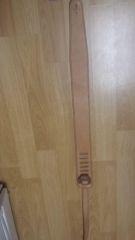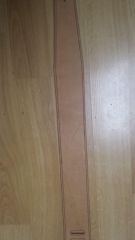-
Posts
1,933 -
Joined
-
Last visited
Content Type
Profiles
Forums
Events
Blogs
Gallery
Everything posted by billybopp
-
It also occurs to me that if timing is that far out, somebody may have disassembled things and not put it back correctly. That might be worth a check. In the video it looks like the hook is positioned on the plate beneath by a rolled pin. That pin might be a shear pin to prevent excessive damage if something jams up, and could be broken. We used to use shear pins like that in some of the big laser printers, check sorters, and other equipment that I worked on in a former life. That might be worth a check too. Hopefully some o' the pros will chip in on this and help you too if they're not worn out by Chinese machine questions. I also just noticed your post from yesterday about the motor cap. Sometimes you can get by without one, but usually not. Read the markings on the capacitor it should give you the info that you need to get a replacement. It'll be marked with some voltage (VAC) and some capacitance, probably in the uf or mf range. A good source for motor caps is http://www.grainger.com/category/category/capacitors/motor-supplies/motors/ecatalog/N-9yp?redirect=capacitor Hope that helps Bill
-
OOPS. Right you are. Here's the link! http://www.youtube.com/watch?v=8pGCn0iw-50 Unfortunately it probably won't be as helpful as I hoped, but the guy does show how to re-assemble and lube the bobbin area which you will probably want to do along with the timing as well as now and then afterward. He does give us a clue, tho that timing is not set in that immediate area with this machine. If you look at the link that dirtclod posted above, page 2, entry 2 by CowboyBob mentions a belt that can cause timing problems. That may give you a starting point and an idea what to look for in the service manual. Google translate might be helpful at that point. Wish I could tell you more, but I don't know much more about sewing machines than you do, but I'm following a lot of the sewing machine threads so that when I do finally go that route, I'll have some info under my belt. Hope that helps! Bill
-
I poked around a little on youtube and found this video for ya. If the guy is correct, the 267 in this video should be very similar to, if not identical to the 67 and 167, at least in the bobbin area ... That's what he said at the very end of the vid. Between that, your German service manual, Google translate, sister-in-law, and here .. You'll get it working. And we'll anxiously be waiting to see how creative you get with it!! Bill
-
Are you talking about these? http://www.ebay.com/itm/Snap-On-Tool-Snap-Pressing-Machine-Kit-Various-Moulds-Dies-Sets-Snap-Fasteners-/181454214405?pt=LH_DefaultDomain_0&var=&hash=item2a3f839505
- 9 replies
-
- spring snap
- glove snap
-
(and 2 more)
Tagged with:
-

Arbor Press One Ton
billybopp replied to Red Cent's topic in Gun Holsters, Rifle Slings and Knife Sheathes
Red! Looks like you got a pretty nice gift there! I don't make holsters, but I understand that some folks use their arbor press in forming the leather for form-fitted holsters somehow. There are tons of things that you can do with the press including setting rivets and snaps, punching holes, and stamping. There's a video on Youtube showing how one guy modified his arbor press for setting snaps and rivets. ... http://www.youtube.com/watch?v=ZVyV3ZTVpqY He is just using the standard hand setting tools in his arbor press, which works OK. You could also use the dies that Tandy and others sell by modifying the ram and base to take those if you do enough of them to justify the expense of the dies. Another guy sells a modified press on ebay to use for stamping, it should give you some ideas for that sort of use ... http://www.youtube.com/watch?v=vBb-SsRwS7U My setup is similar to this, replacing the circular part of the base with something flat. In my case, 3/8" plywood, but many prefer a chunk of flat steel. My ram hasn't been drilled, but it would be if I had a drill press! This guy's idea of building up a flat table either side of the press is a good one. It lets you keep the piece you're working on flat as you work which is helpful. Chiefjason's idea for adapting a drill chuck would probably work well with your 2 ton, as it probably has a longer throw than my 1/2 ton. I'm really happy that my stamps don't bounce and make ghost images anymore! If you want to use it to punch holes, blackriverlaser now has a nice hole punching die set that you could easily adapt. Or you could just find a way to chuck up your punch tubes and put something soft under the leather being punched. There are a few ideas ... I'm sure there are many more! Bill -

Buying Keestar Sewing Machine 441 Directly From China..
billybopp replied to korokan's topic in Leather Sewing Machines
If you think that's bad Kevin. Your computer is now infected with a virus will cause your computer to hack some secured networks sending the info back to China. You can expect the FBI to knock at your door any day now. -
I really like the gel Mahogany, saddle tan and tan. It always smears a little bit with the first coat of sealer, but usually that's not too bad. Some months ago, I made some arm bands using Mahogany and Saddle Tan with 2-3 coats of resolene to seal. They seemed to be fine until I wore them out a few weeks ago as the weather got hot and sweaty. The dye bled profusely with sweating and left me with some lovely colored stripes on my arms. While I was able to get the dye mostly off when I got home, it was not a good day! I'll find something else to use for that sort of thing from now on. Bill
-
I like the color you get from the Mahogany, Saddle Tan and Tan antique gels. But I made some arm bands using Mahogany and Saddle Tan. They seemed fine until I wore them on a hot and sweaty day. I now have nice marks on my arms where the dye bled profusely, through about three layers of Resolene. So it's certainly a no-go for that sort of thing from now on for me. Bill
-
What Tom said! Most cell phones and services will allow you to text or email a picture to yourself, which you can then download onto your PC to upload here. Some will even offer to reduce the file size which is usually a good idea. Most cell phones will also let you copy pictures onto your computer via a USB cable. Still others use a removable memory card (NOT the SIM card) for which you can get a USB adapter. Hope that helps! Bill
-

Well... What About Coins?
billybopp replied to Sona's topic in Purses, Wallets, Belts and Miscellaneous Pocket Items
You are right. US currency goes down to $1, so that is very likely why. And yes, it does make for a slimmer wallet, which is kind of important if you keep it in a back pants pocket. We do sometimes see women carry wallets with a coin pocket, since they are more likely to keep their wallet in a handbag ... Where it isn't uncomfortable. Bill -

Well... What About Coins?
billybopp replied to Sona's topic in Purses, Wallets, Belts and Miscellaneous Pocket Items
Good question! Here in the US, most of us ... Men especially ... do not keep coins in wallets, but rather loose in pockets or a separate coin purse. I understand that it is far more common to keep change in a wallet in the rest of the world. If you want a pattern for a wallet with a change pocket, Ian Atkinson offers one on his Etsy store. https://www.etsy.com/listing/186830794/build-along-leather-pattern-2-coin-and?ref=shop_home_active_2 He also has a video of construction of one of these wallets on youtube. http://www.youtube.com/watch?v=pNXfMC0SqP4 I hope that helps. Bill -

Colored Thread Retailer For Colors Besides Black-White-Brown
billybopp replied to Tallbald's topic in Leather Sewing Machines
This isn't entirely on topic, but I'd like to get some multi-colored thread for an upcoming project. I have not yet ventured into the world of leather sewing machines, so it will be hand sewn. I've looked around a bit but have not yet seen anything that looks usable for me. It probably does not help that I'm totally mystified by thread sizes unless it's in mm. I usually use .8mm or 1mm poly thread. Does anybody have suggestions? Bill -
Gray and white dye appear to be of the same type .. They both come in glass and smell like a$$. However, the gray goes on fairly nicely with a brush using just one or two coats. I just bought some white for an upcoming project, and after trying it on a test piece ... It's a pain in the neck. White dye takes many many coats to get any kind of coverage with a brush or dauber. Each successive coat seems to mess with the previous one, but maybe I was rushing things and not allowing enough time to dry. If I end up using it for my project, it will be sprayed on. I may just go with a thinned acrylic paint. Bill
-
Just a note .. If you're going to buy from goodsjapan, either directly or through e-bay, go for the expedited shipping rather than free shipping unless you are very VERY patient. I've waited nearly two months for delivery when using free shipping. Expedited is something like $4 or $5 per item and deliver is more like two weeks. I'd also suggest pokin' around on the http://www.goodsjapan.jp/ website. I've ordered the pricking irons you're looking at from them plus awls and a really effective burnishing cream. Irons and awls from them needed less work than any others I've used so far to make them usable. Bill
-

Rifle Scabbard
billybopp replied to Manypawz's topic in Gun Holsters, Rifle Slings and Knife Sheathes
Looks good! -
Y'all keep this up and they're gonna have to move this to the adult forum.
-

How To Run A 3 Phase 380V Motor On 220V
billybopp replied to Constabulary's topic in Leather Sewing Machines
If your motor is designed for dual voltage, it will do no real harm to wire for and run on the lower voltage, however you will get less power from it. How much less depends on the internal design of the motor. Bill -

Bidding On Ebay For Leather Stamping Tools
billybopp replied to WyomingSlick's topic in Leather Tools
Interesting question! At least this listing shows you the tool faces, which is very helpful. A little rust on a handle is no big deal. Rust on the tool face makes it pretty much unusable. Some of the tools are potentially pretty valuable, but I'm no expert on that and only buy to use. If I needed 4 or 5 of the usable tools, I'd bit 60ish. Otherwise, I'd pass. I've had generally good luck buying on ebay, with just one or two disappointments. The savings on the good buys more than offsets the cost of the disappointments for me. Bill -
If you think about it, it probably makes sense that twist could be a factor for some people and not for others. It's a pretty easy thing to, even without knowing it, twist the needle and thread in your hand as you are pulling or even when re-positioning the needle. Since people do not necessarily stitch the same way, some might be more prone to twist clockwise and others counterclockwise which would cause the thread to tighten or loosen depending on which type. Others could twist one way with one hand and the other way with the other hand which would negate the thread twist. Bill
- 18 replies
-

Cutting/hole Punch Board - Hydroma, Poly Or Other
billybopp replied to barehandcustoms's topic in Leatherwork Conversation
I used to use a kitchen cutting board, and it worked fine. This one was pretty soft and occasionally when punching small holes, little bits of leather would pull out of the punch and stick in it. Not a big problem, really. ... Until one day the spousal unit came across it ( we were dating at the time ) ... and threw it away while I was out .. Saying "It had WORMS growing in it .. You're disgusting". I now use a black Tandy poundo board. Bill -

Heirloom Sketch Book Cover
billybopp replied to Quillleather's topic in Purses, Wallets, Belts and Miscellaneous Pocket Items
Very nice indeed! I LOVE the idea of using the pen as clasp. That's something I've never seen before. Bill- 7 replies
-
- drawing
- sketchbook
- (and 5 more)
-
Very nice! What did you use on the back-side of leather to protect the picture from the leather?
-
From the album: Billybopps Stuff
-
From the album: Billybopps Stuff




